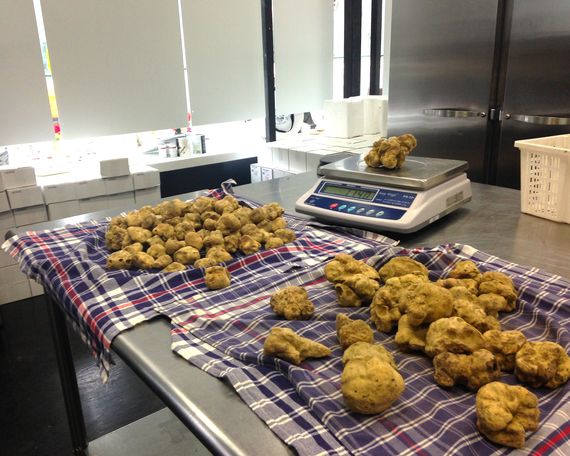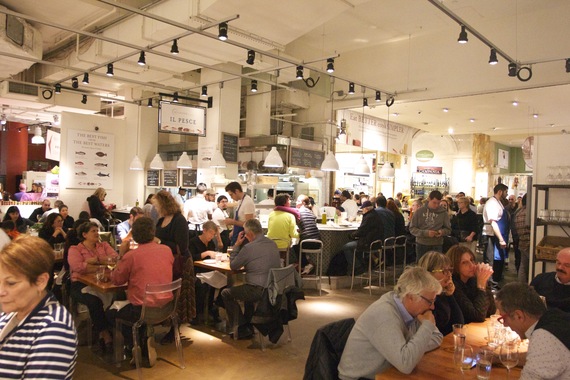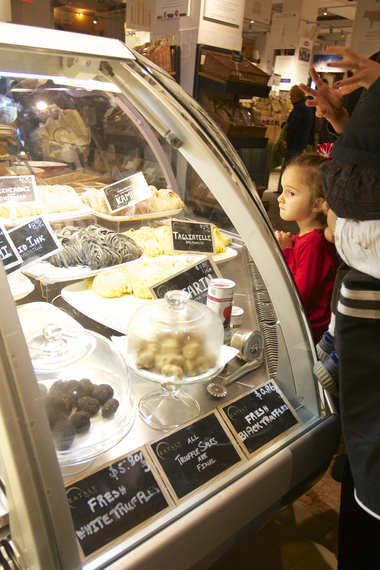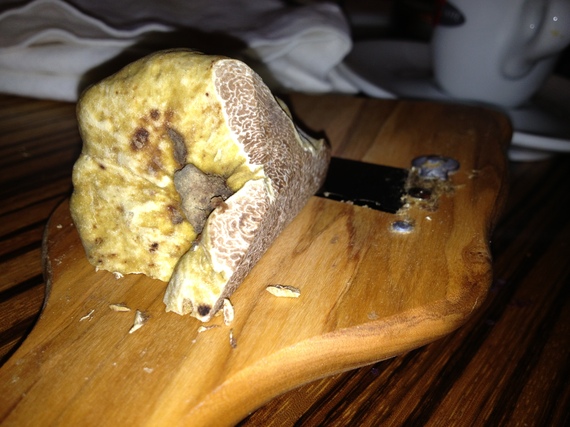Enormous white truffles are landing in New York from Italy earlier than usual this year. This is a boon for diners eager to taste the rich, aromatic shavings of this bulbous fungus on everything from filet mignon to french fries. However, their surplus could also spell trouble for the gourmet reputation of truffles.

All photos © 2014 Maya Albanese Photography, All Rights Reserved.
As truffles become more widely available, high-profile chefs and entrepreneurs are experimenting with inventive creations, such as $250 truffle-smothered hamburgers and truffle-infused beers. NYEater has even developed a map app that directs New Yorkers to where they can eat truffles right now.
Meanwhile, some food celebrities are protesting the proliferation of truffle products. In March, Martha Stewart posted on the social news site Reddit, “I think truffle oil is one of the few ingredients that doesn’t belong in anyone’s kitchen. It is ruinous of most recipes.”
But, a significant increase in business at companies like Urbani, the world’s largest truffle trader that controls 70 percent of the market, shows that the popularity of truffles continues to explode. The company’s sales have increased between 25 and 35 percent each year over the last five to six years.
When the large glass doors to the Urbani store on the Upper West Side of Manhattan are buzzed open, an intoxicating aroma envelops everything in its path. The matchless scent emanates from a 150 pounds of fresh white truffles, just in from Italy.
Vittorio Gioridino, Vice President of Urbani USA, pulls wooden crates lined with cloth from a giant, steel fridge. He spreads out an array of truffles on the kitchen table that range in size from baseballs to marbles. He picks up the largest one and rolls it over in his hand to point out its distinctive dirt-filled crevices, and brings it up to his flared nostrils. “I don’t indentify the best truffles by size or shape but by smell. That is the beauty of the truffle,” he says.
Truffles are the fruits of underground fungi that grow in symbiosis with trees. There are hundreds of species of wild and cultivated truffles, but the white Alba truffle from Italy is the most expensive food in the world with an average price per pound in the $2,000 to $3,000 range over the last decade, but with peaks as high as $5,000. According to Giordino, prices are attractive at the moment. Urbani’s latest shipment is selling to consumers at an average of $6 per gram, or $2,722 per pound.
The most prized edible truffles have historically come from Italy and France, but today, there are cultivated varieties from countries including the U.S., U.K., Spain, Germany, Albania, Sweden, Chile, Australia, New Zealand, and China. An increase in global supply has resulted in more market competition and lower prices.
“In the last nine years, a lot of things have changed in the truffle business,” says Giordino. “Now, you can find truffles everywhere, even in mac and cheese.” In addition to Urbani, truffles are sold at Eataly, Citarella Markets, Buon Italia in Chelsea Market, and Dean & Deluca.

At Eataly, a mega consortium of Italian restaurants and shops on 5th Avenue in Manhattan, there is seldom a crowd-less moment. Frantic shoppers paw over grocery items, gifts, and cookbooks. A persistent din of clinking glasses and stacking plates fills the atmosphere with a sense of constant merriment. During the lunch hour rush, every dining table is filled with people savoring pizzas dripping with truffle oil or sipping on large glasses of red wine.
At the market’s pasta counter, two glass pedestals are covered with glass tops in order to safeguard the precious fragrance of the truffles within. Customers encircle the counter’s display to ask for black truffles at $.86 per gram and white truffles at $5.80 per gram. A woman points aggressively to the exact white truffle that she wants while a mother holds her curious young daughter’s fingers back from dirtying the glass.

Frank Prisinzano, a chef and food personality who owns four Italian restaurants in NY has been harvesting truffles in Italy since his childhood. He lamented, “There is so much ignorance about truffles. People say, ‘Oh I don’t like truffles!’ But, they’re not even eating truffles! They’re eating truffle oil, made in a perfume factory. Some manner of truffle may be involved, maybe, depending on the factory, but sprinkling truffle oil on it? They would shoot you in Piemonte if you did this!”
Truffle oil, used to make foods like truffled french fries, is not made from fresh truffles. The “truffle essence” or “truffle aroma” in the ingredients list is a petroleum-derived compound manufactured in a laboratory that is mixed with other cheaper oils and chemicals.
Many chefs in the gourmet community are already aware of this fact. In season 2 of Guilty Pleasures, Anthony Bourdain said, “Let it be stated here, unto forever and eternity, truffle oil is not food.” However, most diners are still unaware that they are not savoring the real deal when they order a dish with the word “truffle” in its name.
“How can you make a profitable and scalable business out of something that’s $3,000 per pound? It’s bastardization. The truffle market is a perfect storm for a conman: you have a delicate product that is super expensive and no one really knows anything about it,” Prisinzano says.
Prisinzano is a purist. He says that the only way one can truly understand and appreciate the truffle is to consume a fresh white one from Alba within ten days of harvest. The truffle must be very finely shaved just underneath the nose to release its heady fragrance, and served only on simple foods like plain risotto, pasta, or best of all, he says, on a fried egg.

Large Alba white truffle at one of Prisinzano’s seasonal truffle dinners in New York.
But for diners who cannot pay such a hefty price tag or visit Italy, he offers, “If you had to choose a truffle product, maybe the best bet is Urbani’s truffle butters that have chopped white truffles inside.”
The mass-marketization of truffles, which is resulting in the dilution of quality and deception of diners, is not the only trouble for the truffle. Some scientists are hypothesizing that unpredictable year-to-year variations in truffle harvests in Europe are caused by erratic weather patterns associated with climate change.
Truffles are especially sensitive to climate, because they are seasonal, wild produce. A scientific study conducted by The Ecological Society of America in April 2011 highlights abundant harvests in Southwest Germany, an area traditionally outside of the natural truffle growing region, as a clear indication how the long-term effects of climate change are altering supply.
“Winter months are becoming milder and summer truffle fruiting seasons wider, so some species are moving northwards, and prices are likely to increase, ” explains Dr. Paul Thomas, Director at Mycorrhizal Systems and Chief Scientist at the American Truffle Company.
Variable weather patterns associated with climate change are also affecting truffle and mushroom harvests in the Pacific Northwest of the U.S. Anthony Tassinello, a restaurateur and alumnus of Alice Waters’ Bay Area restaurant Chez Panisse, forages for a variety of wild mushrooms. In the last fifteen months, Tassinello has had to travel to Oregon and Washington five times, because wild mushrooms have been so scarce in California. “I usually go foraging just after the first fall rains, but it doesn’t rain anymore in California,” he said. “I have been foraging since 1997, and I have noticed a decline in certain populations of mushrooms because of extended drought.”
Dr. Thomas acknowledges that it is difficult to get accurate truffle supply data. “The white truffle is a really complex industry. There are many different species coming from all over the world that are being mixed to decrease the price of the product,” he says.
The secretive nature of the industry also makes it impossible to calculate reliable numbers. Tassinello described his experiences, “Oh yes, truffles are corrupt! I’ve been to the truffle markets and hunted them in Italy. The best of the true white truffles aren’t sold in the market…those are back-alley deals.”
Despite the plethora of truffle products in markets all-year-round, chefs and foodies are anticipating paying top-dollar this year to relish the fresh truffle flavor that Tassinello pointedly describes, “It goes up into your palate, shoots through your sinuses and right through your head.”
Truffle season in Italy officially kicked off on the first of this month. Prisinzano will travel to Alba this week harvest what he declares is “one of the most incredible and purest things that the earth produces.”
Follow Maya Albanese on Twitter: www.twitter.com/mayaalbanese


